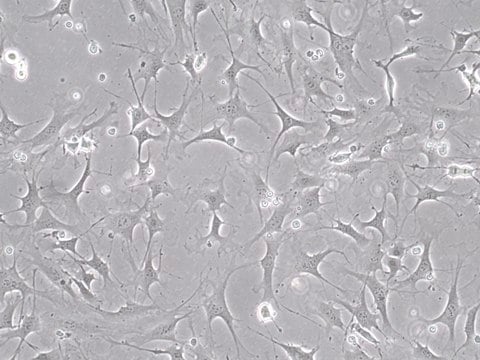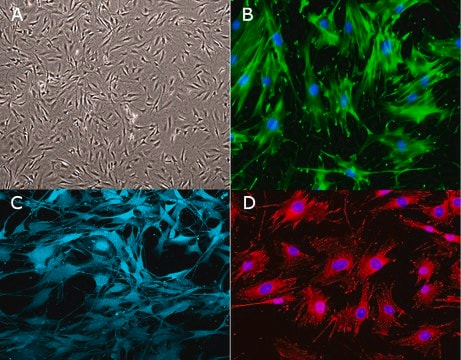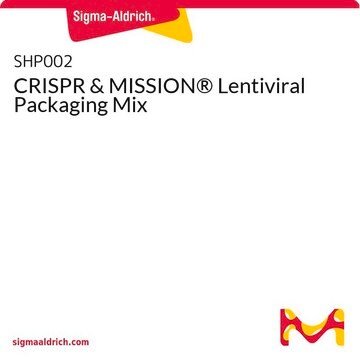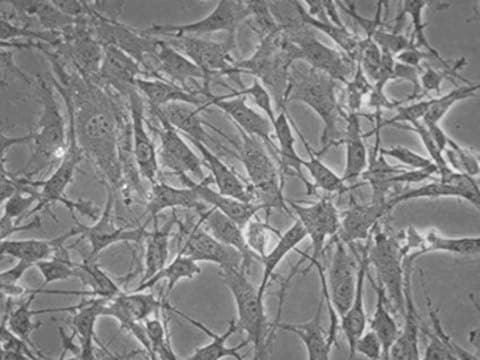SCC495
Mouse OP9-DL4 Notch Ligand Cell Line (-GFP)

Synonym(s):
DL4 cell line, Delta-like 4 cell line, Notch ligand cell line, OP9-DL4, OP9-DL4 cell line
Sign Into View Organizational & Contract Pricing
All Photos(1)
About This Item
UNSPSC Code:
41106514
NACRES:
NA.81
Recommended Products
biological source
mouse
Quality Level
packaging
vial of ≥1X10⁶ cells/vial vial
manufacturer/tradename
Millipore
technique(s)
cell culture | mammalian: suitable
shipped in
liquid nitrogen
storage temp.
−196°C
Application
- Each vial contains > 1X106 viable cells.
- Cells are tested negative for infectious diseases by a Mouse Essential CLEAR Panel by Charles River Animal Diagnostic Services.
- Cells are verified to be of mouse origin and negative for interspecies contamination from human, rat, Chinese hamster, Golden Syrian hamster, and nonhuman primate (NHP) as assessed by a Contamination Clear panel by Charles River Animal Diagnostic Services
- Cells are negative for mycoplasma contamination.
Features and Benefits
OP9-DL4 (-GFP) is a stable bone marrow derived stromal cell line expressing the Notch ligand-Delta like 4 (DL4) with the GFP coding region removed for stem cell differentiation applications.
Target description
OP9-DL4 is a stable bone marrow derived stromal cell line expressing the Notch ligand- Delta like 4 (DL4) ectopically.
Notch signaling controls multiple cell-fate decisions. Four Notch receptors (Notch 1- Notch 4) have been identified in mammals. These receptors interact with Jagged or Delta-like (DL) family members of Notch ligands. This is followed by cleavage of the intracellular domain of Notch and its subsequent translocation into the nucleus, where it binds with transcription factors and activates transcription of various downstream target genes. Notch signaling is essential in early T- cell lineage commitments. Bone marrow progenitor cells expressing constitutively-active Notch develop into CD4 and CD8 double positive T cells rather than B cells. They also play an important role in development of CD4+ and CD8+ single positive cells from double positive precursor thymocytes, in addition to development of T-cells with αα+ TCRs. Of the 4 Notch receptors, Notch1 (N1) receptor signaling has been shown to be sufficient for T cell development. The delta like ligands are physiologically relevant N1 ligands. DL1 interacts with both N1 and Notch 2 (N2) to induce T- cell lineage commitment. However, DL4 interacts specifically only with N1 and supports T cell commitment and maturation both in vitro and in vivo. Moreover, results from previous binding studies show that binding between DL1 and N1 is weak as opposed to the stronger binding between DL4 and N1. Of the DL1 and DL4 delta like ligands, DL4 exhibits greater capacity to activate the Notch pathway in hematopoietic progenitor cells.
SCC495 OP9-DL4 Cell line has had the GFP coding region removed from the original pMiGR plasmid, resulting in no GFP expression for this cell line.
Source
OP9-DL4 cells were genetically modified from OP9 stromal cells derived from mouse bone marrow.
References
1. Immunity 2002, 17(6): 749-756.
2. J Orthop Sci. 2005, 10(6): 589-594.
3. Curr Opin Immunol. 2007, 19(2): 163-168.
4. Cold Spring Harb Protoc. 2009, 2009(2): pdb.prot5156.
Notch signaling controls multiple cell-fate decisions. Four Notch receptors (Notch 1- Notch 4) have been identified in mammals. These receptors interact with Jagged or Delta-like (DL) family members of Notch ligands. This is followed by cleavage of the intracellular domain of Notch and its subsequent translocation into the nucleus, where it binds with transcription factors and activates transcription of various downstream target genes. Notch signaling is essential in early T- cell lineage commitments. Bone marrow progenitor cells expressing constitutively-active Notch develop into CD4 and CD8 double positive T cells rather than B cells. They also play an important role in development of CD4+ and CD8+ single positive cells from double positive precursor thymocytes, in addition to development of T-cells with αα+ TCRs. Of the 4 Notch receptors, Notch1 (N1) receptor signaling has been shown to be sufficient for T cell development. The delta like ligands are physiologically relevant N1 ligands. DL1 interacts with both N1 and Notch 2 (N2) to induce T- cell lineage commitment. However, DL4 interacts specifically only with N1 and supports T cell commitment and maturation both in vitro and in vivo. Moreover, results from previous binding studies show that binding between DL1 and N1 is weak as opposed to the stronger binding between DL4 and N1. Of the DL1 and DL4 delta like ligands, DL4 exhibits greater capacity to activate the Notch pathway in hematopoietic progenitor cells.
SCC495 OP9-DL4 Cell line has had the GFP coding region removed from the original pMiGR plasmid, resulting in no GFP expression for this cell line.
Source
OP9-DL4 cells were genetically modified from OP9 stromal cells derived from mouse bone marrow.
References
1. Immunity 2002, 17(6): 749-756.
2. J Orthop Sci. 2005, 10(6): 589-594.
3. Curr Opin Immunol. 2007, 19(2): 163-168.
4. Cold Spring Harb Protoc. 2009, 2009(2): pdb.prot5156.
Storage and Stability
OP9-DL4 (-GFP) cells should be stored in liquid nitrogen. The cells can be cultured for at least 10 passages without significantly affecting cell marker expression and function.
Other Notes
This product is intended for sale and sold solely to academic institutions for internal academic research use per the terms of the “Academic Use Agreement” as detailed in the product documentation. For information regarding any other use, please contact l
Disclaimer
Unless otherwise stated in our catalog or other company documentation accompanying the product(s), our products are intended for research use only and are not to be used for any other purpose, which includes but is not limited to, unauthorized commercial uses, in vitro diagnostic uses, ex vivo or in vivo therapeutic uses or any type of consumption or application to humans or animals.
Storage Class Code
10 - Combustible liquids
WGK
WGK 3
Flash Point(F)
Not applicable
Flash Point(C)
Not applicable
Certificates of Analysis (COA)
Search for Certificates of Analysis (COA) by entering the products Lot/Batch Number. Lot and Batch Numbers can be found on a product’s label following the words ‘Lot’ or ‘Batch’.
Already Own This Product?
Find documentation for the products that you have recently purchased in the Document Library.
Our team of scientists has experience in all areas of research including Life Science, Material Science, Chemical Synthesis, Chromatography, Analytical and many others.
Contact Technical Service








